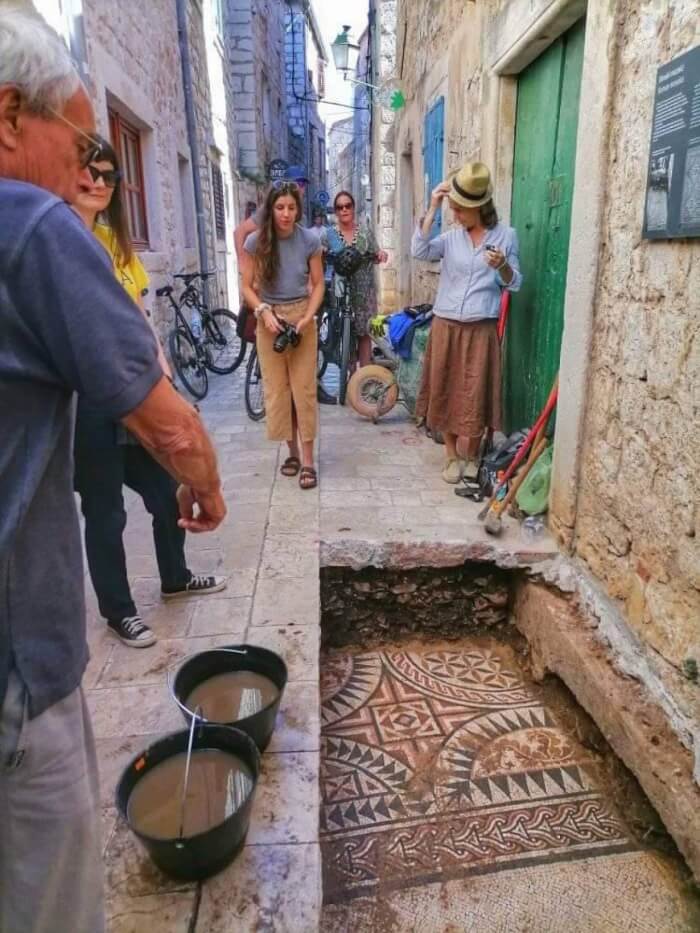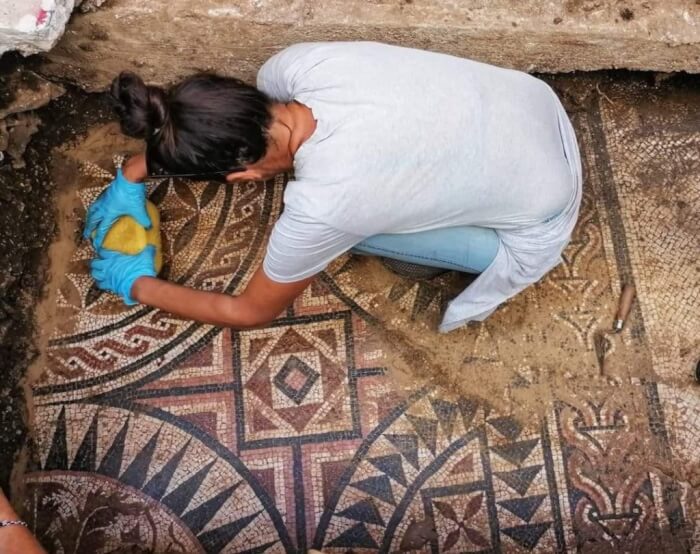Roman Mosaic Discovered In The Croatian Town Of Hvar
A Roman mosaic was excavated under the pavement beneath a narrow street in the Old Town on the Adriatic island of Hvar, Croatia.
Archaeologists believe that the elaborate geometric mosaic floor dates back to the 2nd century A.D. and was part of a luxurious Roman villa urbana, a splendid city mansion showing the lifestyle of the upper classes, in which those able to afford tried to bring Rome’s living standard to the farthest provinces.
To construct a canal for rainfall drainage, the site was uncovered in 1923, and the villa’s remnants were discovered 2 feet below street levels. Then, the findings were finally covered with slabs and reburied, in order to be safeguarded from water intrusion.
The locals prefer to keep the mosaic remnant in place, covered with plexiglass so that they can comfortably observe them while still be able to preserve them. However, the street is no longer dry land as the sea level has inclined by 1.5 ft since the mosaic was created. And the new water pipe system is being set up as well, only a few inches above the mosaic.
Dr. Sara Popović and archaeologist Andrea Devlahović, on behalf of the Old Town Museum, are conducting activities related to the unearthing of the mosaic.
Fourteen additional sites near the mosaic location are currently excavated on the lookout for further fragments from the villa urbana. Archaeologists are also seeking other mosaics and any evidence that might identify the structure, or at least able to identify it as a public or private facility. Maybe after the digging up is completed, the authorities will have a clearer sense of what to do next.
Dr. Popović and Devlahović has suggested lifting the mosaic up to transfer it to the museum for long-term preservation and future exhibition, while the mosaic will be replaced by a replica that can be walked over freely without being impaired.
However, the proposed solution will have to wait for approval by conservators and heritage officials from Split, Croatia.
Historically, the island of Hvar was conquered by Rome in the 3rd century BC. Its Roman name is Pharos, and its Latin name is Pharia, while the plain’s new name became Ager Pharensis. The Slavs invaded the island at the beginning of the 8th century, renaming it to the ancient name Hvar, for both the town and island.
Archaeologists believe that the elaborate geometric mosaic floor dates back to the 2nd century A.D. and was part of a luxurious Roman villa urbana, a splendid city mansion showing the lifestyle of the upper classes, in which those able to afford tried to bring Rome’s living standard to the farthest provinces.
To construct a canal for rainfall drainage, the site was uncovered in 1923, and the villa’s remnants were discovered 2 feet below street levels. Then, the findings were finally covered with slabs and reburied, in order to be safeguarded from water intrusion.
 Source: Pinterest
Source: Pinterest
The locals prefer to keep the mosaic remnant in place, covered with plexiglass so that they can comfortably observe them while still be able to preserve them. However, the street is no longer dry land as the sea level has inclined by 1.5 ft since the mosaic was created. And the new water pipe system is being set up as well, only a few inches above the mosaic.
Dr. Sara Popović and archaeologist Andrea Devlahović, on behalf of the Old Town Museum, are conducting activities related to the unearthing of the mosaic.
 Source: Pinterest
Source: Pinterest
Fourteen additional sites near the mosaic location are currently excavated on the lookout for further fragments from the villa urbana. Archaeologists are also seeking other mosaics and any evidence that might identify the structure, or at least able to identify it as a public or private facility. Maybe after the digging up is completed, the authorities will have a clearer sense of what to do next.
Dr. Popović and Devlahović has suggested lifting the mosaic up to transfer it to the museum for long-term preservation and future exhibition, while the mosaic will be replaced by a replica that can be walked over freely without being impaired.
However, the proposed solution will have to wait for approval by conservators and heritage officials from Split, Croatia.
Historically, the island of Hvar was conquered by Rome in the 3rd century BC. Its Roman name is Pharos, and its Latin name is Pharia, while the plain’s new name became Ager Pharensis. The Slavs invaded the island at the beginning of the 8th century, renaming it to the ancient name Hvar, for both the town and island.
Share this article
Advertisement